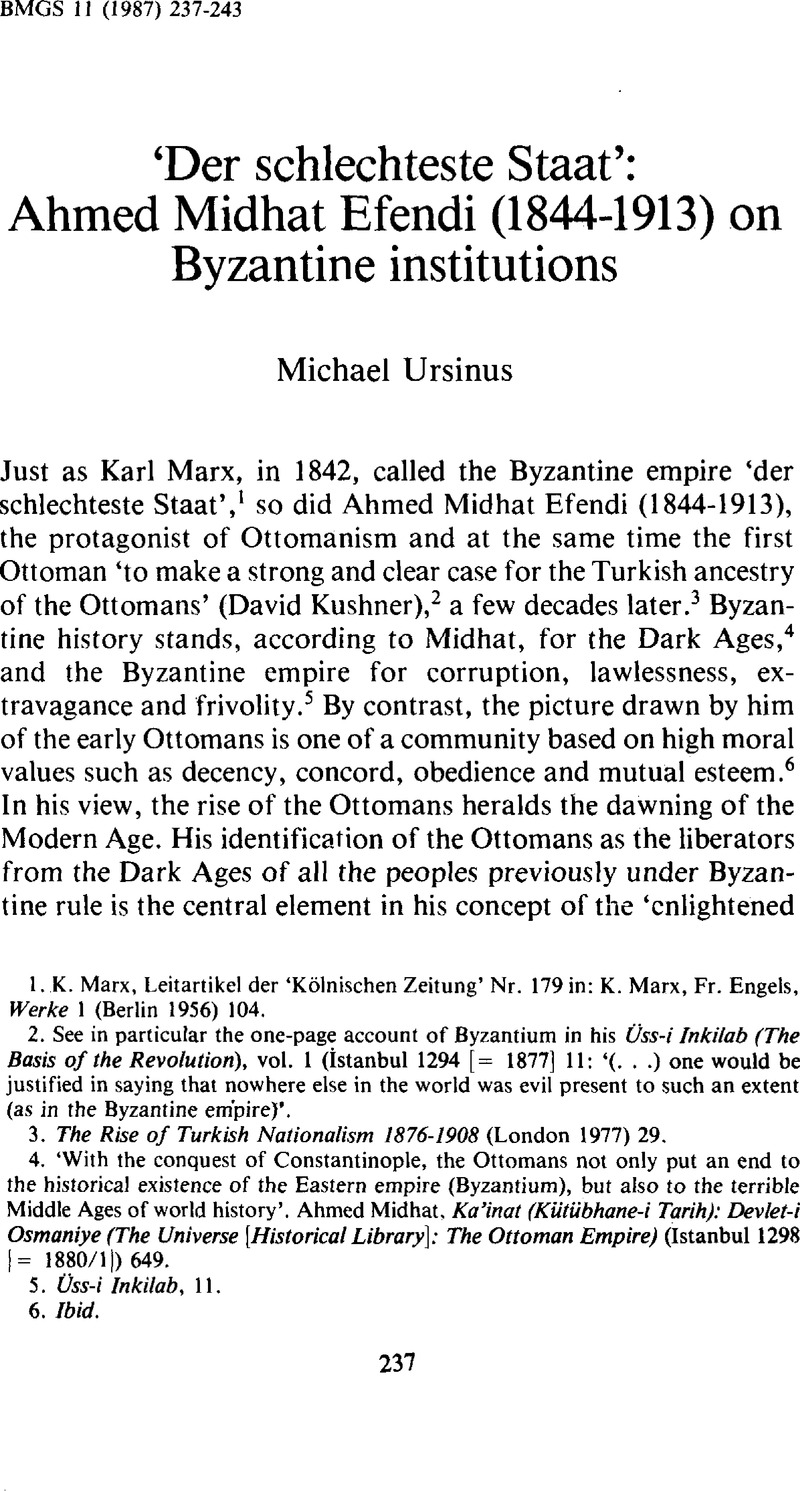Published online by Cambridge University Press: 22 January 2016

1. Marx, K., der, Leitartikel ‘Kólnischen Zeitung’ Nr. 179 in: Marx, K., Engels, Fr., Werke 1 (Berlin 1956) 104.Google Scholar
2. See in particular the one-page account of Byzantium in his Üss-i Inkilab (The Basis of the Revolution), vol. 1 (Istanbul 1294 [= 1877] 11: ‘(• • •) one would be justified in saying that nowhere else in the world was evil present to such an extent (as in the Byzantine empire)’.
3. The Rise of Turkish Nationalism 1876-1908 (London 1977) 29.
4. ‘With the conquest of Constantinople, the Ottomans not only put an end to the historical existence of the Eastern empire (Byzantium), but also to the terrible Middle Ages of world history’. Ahmed Midhat. Ka’inat (Kiitubhane-i Tarih): Devlet-i Osmaniye (The Universe [HistoricalLibrary]: The Ottoman Empire) (Istanbul 1298 |= 1880/11) 649.
5. Üssi Inkilab, 11.
6. Ibid.
7. ‘To save the oppressed of the East and to grant them personal and national freedom as well as religious and political privileges, the (mere) necessity for a general uprising as in Europe was not sufficient; what was needed was rather a championlike performance (realised) with the appearance of a group of believers (destined) to save the world. It does not need to be emphasized that this group of believers were the Ottomans’. Ka’inat, 625.
8. 3 vols, (istanbul 1303-1305 [= 1885/6-1887/8]).
9. Mufassal Tarih-i Kurun-i Cedide, vol. 2, 269: ‘Whether the rise of the Ottomans was to the benefit of the civilisation of mankind or to its detriment will become apparent by comparing Ottoman history with that of the Eastern Roman empire’.
10. Nizac -illm ve Din (The Conflict Between Science and Religion), vol. 1 (ìsianbul 1313 [;= 1895/6]) 280f.
11. Müdafac a (Defense), vol. 3 (islanbul 1302 |= 1884/5|) 507f.
12. Ka’inat, 214, 649.
13. Op.cit. 649.
14. An excellent general account of Midhal Efendi’s life and works is Akyiiz, K., ‘La littérature moderne de Turquie,’ Philologiae Turcicae Fundamenta 2 (Wiesbaden 1965) 494–500.Google Scholar
15. Ahmed Midhat, Mufassal II, 319f.
16. Ibid., 327f.
17. Ibid., 324.
18. Ibid., 325-27.
19. Ahmed Midhat, Mufassal II, 322, with a reference to Cesare Cantu’s Storia Universale (35 vols., 1838-47). This author is no doubt identical with the ‘Canetto’ in my earlier Note, where it must read ‘Cantu’: see BMGS 10 (1986) 216 and n.23. The source for this account seems to lie in a paraphrase of accounts in the De Caerimoniis dealing with imperial triumphs, the preparations to be observed upon an emperor’s return from war. In fact, the heads were not cut off at all, the emperor merely placing his right foot on the head of the higher-ranking ‘Saracen’ captive: see De Caer (Bonn) 610: 16-21; and see 611: 5-7 for the acclamation of the Kyrie eleeson. I am grateful to my colleague John Haldon for this reference.